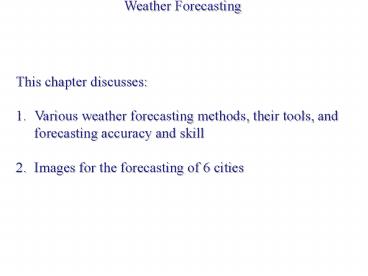Weather Forecasting - PowerPoint PPT Presentation
1 / 30
Title:
Weather Forecasting
Description:
Various weather forecasting methods, their tools, and forecasting accuracy ... in multiple windows is facilitated with the National Weather Service's Advanced ... – PowerPoint PPT presentation
Number of Views:2213
Avg rating:5.0/5.0
Title: Weather Forecasting
1
Weather Forecasting
- This chapter discusses
- Various weather forecasting methods, their tools,
and forecasting accuracy and skill - Images for the forecasting of 6 cities
2
Analysis to Prognosis
Figure 14.1A
Figure 14.1B
3
Three important forecasting steps are 1) Assess
the present state, called the analysis, by
plotting 6 hourly surface and 12 hourly sounding
data 2) Predict a future state by running a
computer model of weather changes 3) Interpret
the model results, called a prognostic chart,
given forecasting experience Here are two
different model 500 mb progs.
4
Viewing Data with AWIPS
Figure 14.2
Viewing weather images, overlays, and graphs in
multiple windows is facilitated with the National
Weather Service's Advanced Weather Interactive
Processing System (AWIPS), which gathers data
from the Automated Surface Observing System among
other sources.
5
WSR-88D Doppler Radar
Weather Surveillance Radar - 1988 Doppler, also
known as next generation radar (NEXRAD), detects
severe weather size, movement, and
intensity. Data received by the NEXRAD unit are
processed by algorithms to assist the forecaster
in weather interpretation.
Figure 14.3
6
Meteogram Display
Predicted trends in several weather variables are
plotted for a 60 hour period on a
meteogram. Patterns in variable response, such
as rising pressure and a stop in precipitation,
are readily observed.
Figure 14.4
7
Vertical Sounding Profile
Radiosonde instruments attached to pilot balloons
are launched twice daily to profile weather
variables with height. These January 14, 1999
data show winds veering from easterly at the
surface to southwesterly aloft that may change
the freezing rain in the saturated lower
atmosphere to non-freezing rain.
Figure 14.5
8
Probability Forecasts
Figure 14.6
Climate records, often 30 years of data, are used
to generate probability forecasts for a given
event. In this case, most of Texas has a less
than 5 chance of snow on December 25th, while
northern Minnesota has had snow on that date for
each of the past 30 years.
9
Weather Forecasting Methods
Figure 14.7
10
Several methods are used to forecast weather, and
include 1) Persistence - the future will be
like the present 2) Trend - the future will be
like upwind weather 3) Analogue - the future
will be like weather that historically occurred
when similar conditions were present In this
figure, the forecasting method is called weather
types, which is a type of long range analogue
forecast.
11
Weekly Monthly Forecasts
Stationary weather systems often allow for trend
based extended weather forecasts, while multiple
runs of numerical weather models, known as
ensemble forecasts, allow for 30 to 90 day
outlooks.
Figure 14.8A
Figure 14.8B
12
Forecasting with Surface Charts
Figure 14.9
Many of the following figures analyze and predict
weather for 6 U.S. cities. This simplified 6 AM
Tuesday surface weather map is useful for short
time interval predictions of fronts and
associated weather.
13
Surface Chart Predictions
Figure 14.10
3-hour pressure tendencies plotted on isallobar
maps help predict the movement of highs and lows
and indicate how rapidly pressure systems are
changing. Lows tend to move toward the region of
greatest pressure fall, while highs move toward
the region of greatest rise. The low from the
previous map will likely move to the NE, while
the high will move to the SE.
14
Upper Level Charts
Figure 14.11
Upper level winds, particularly those at 5500 m,
which is a common elevation for the 500 mb
surface, often guide the path of surface pressure
systems. These upper level winds, however,
travel at nearly twice the speed as the surface
systems. Here again, we see the low will head to
the NE, while the high will head SE.
15
Observed Movement of Fronts
Surface weather observations from 6 PM Tuesday
and 6 AM Wednesday show how the fronts, pressure
systems, and precipitation have moved as
predicted.
Figure 14.12
16
Forecasting Rules of Thumb
17
Forecast Wording
18
Observation Indication Local Forecast
19
Frontal Weather Cold Fronts
20
Frontal Weather Warm Fronts
21
Frontal Weather Occluded Fronts
22
Surface Weather for 6 AM Wednesday
Figure 14.13
23
Surface Weather for 4 PM Sunday
Figure 14.14
24
500 mb Chart for 4 PM Sunday
Figure 14.15
25
Computer Drawn 12, 24, 36 hr Progs
Figure 14.16
26
Surface Weather Map for 4 AM Sunday
Figure 14.17
27
500 mb Chart for 4 AM Suncay
Figure 14.18
28
Infrared Satellite Image for 6 45 AM Monday
Figure 14.19
29
Surface Weather Map for 4 AM Monday
Figure 14.20
30
Visible Satellite Image for 9 AM Tuesday
Figure 14.21































